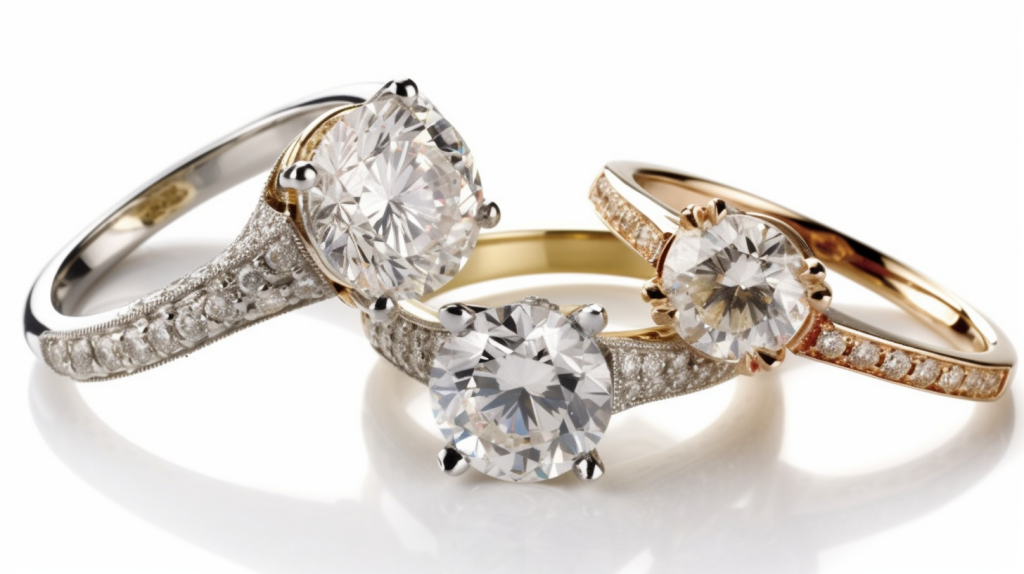Choosing the right metal for your engagement and wedding ring is an integral part of the ring selection process. This isn’t just about aesthetics; it’s about finding a metal that fits your lifestyle, skin sensitivity, personal style, and of course, budget.

Which metal is best for Engagement Rings?
The most popular metals used for engagement rings and wedding rings – gold, silver, and platinum – each possess unique qualities, charm, and allure.
- Gold Engagement Rings – Symbolic of wealth and prosperity, gold has long been the standard for wedding rings. It’s malleable, timeless, and comes in various hues to match different styles. Pick gold if you’re drawn to its timeless appeal, appreciate its softness for more intricate designs, and are drawn to its vibrant hues.
- Silver Engagement Rings – Known for its shiny white color, silver is a more affordable option for those who desire the look of white gold or platinum without the hefty price tag. Its reflective quality enhances the brilliance of the diamond, though it may require more maintenance to keep its shine. Pick silver if you’re budget-conscious but want a ring that shines (keep in mind that silver will require more care to maintain its luster and prevent tarnishing).
- Platinum Engagement Rings – Exuding an air of prestige, platinum is a high-end choice that offers durability and a natural white sheen that doesn’t fade or change color over time. Its density makes it more resistant to damage than other metals, ideal for those who lead an active lifestyle. Pick platinum if you value durability. Its resistance to wear makes it perfect for those who lead active lifestyles or work with their hands. The higher cost of platinum is a worthwhile investment for its longevity.
Let’s delve deeper into each of these metals, cover the types of settings that complement them, and make sure your precious gem sits on the perfect throne. After reading this guide, you’ll be prepared to pick perfectly!
The Glory of Gold
In the realm of precious metals, gold is not just a precious metal—it’s a symbol of human aspiration, a measure of value, and a source of enduring beauty. From the glistening treasures of Egyptian pharaohs to the vast reserves bolstering national economies, gold’s rarity, radiance, and resilience have made it an emblem of enduring worth.
In the realm of jewelry, gold has earned its stature as the “gold standard” for its unique blend of desirable properties. The metal is naturally lustrous and tarnish-resistant, a testament to its timeless charm that can endure generations. Its malleability allows it to be shaped into intricate designs, a trait that artisans have celebrated and exploited for millennia. Yet, despite its softness, gold is incredibly durable, symbolizing an unbreakable bond when used in wedding and engagement rings.
Moreover, gold’s hypoallergenic nature makes it friendly to all skin types, ensuring that its embrace is as tender as the sentiment it conveys. And with advancements in metallurgy, gold has evolved beyond its natural yellow sheen. Today, it adorns our fingers in a symphony of shades—each with its unique pros, cons, and magical allure.
Let’s delve deeper into the vibrant varieties of gold—yellow, white, and rose—and discover how each can reflect your unique love story and personal style.
Yellow Gold
The original and traditional choice, yellow gold, is pure gold mixed with metals like copper and silver to enhance strength.
Pros:
- Timeless and traditional appeal
- Complements warmer skin tones and colored gemstones
- Highly malleable and easy to resize
Cons:
- Can scratch and wear over time
- May need regular polishing to maintain its shine
Suitable settings: Yellow gold is versatile and works well with almost any setting style. Its warm tone particularly enhances vintage-style settings and solitaire designs.
White Gold
White gold is yellow gold alloyed with palladium or nickel, coated in rhodium for a brighter, silver-like finish.
Pros:
- Offers the appeal of platinum at a lower cost
- Complements cooler skin tones and white diamonds
Cons:
- Rhodium plating can wear over time, requiring re-plating
- Potential for allergic reactions if alloyed with nickel
Suitable settings: The contemporary elegance of white gold pairs well with modern, sleek designs and is often used in prong, pave, and halo settings.
Rose Gold
Rose gold, also known as pink or red gold, is yellow gold alloyed with copper to achieve its distinctive blush tone.
Pros:
- Unique and romantic appeal
- Durable due to the strength of copper
- Complements all skin tones
Cons:
- Not as widely available in various designs
- May not be the best choice for those with copper allergies
Suitable settings: The warm, romantic hue of rose gold shines in vintage-inspired settings and beautifully complements intricate designs, halos, and solitaires.
The Splendor of Silver
Silver, with its bright white luster, offers a modern, sleek look that’s versatile and pairs well with many gemstones. Its affordability relative to other precious metals also makes it a popular choice, particularly for couples seeking a cost-effective option without compromising on beauty.
Pros of Silver
- Affordability: Silver is considerably less expensive than gold or platinum, making it a more budget-friendly choice.
- Versatility: Its bright white color complements many gemstones and suits a variety of styles.
- Malleability: Silver is a soft metal, making it easier for jewelers to mold into intricate designs.
Cons of Silver
- Tarnish: Silver can tarnish over time, which may require regular cleaning to maintain its shine.
- Durability: Being softer than gold and platinum, silver is more prone to scratches and wear over time.
Suitable Settings: Silver’s versatility and malleability make it suitable for a variety of ring settings. From the classic solitaire and prong settings to more intricate halo or pavé settings, silver can accommodate them all. However, due to its relative softness, it’s important to ensure that the setting securely holds the gemstone in place to prevent any potential damage.
When paired with bright, colorful gemstones like amethyst, garnet, or turquoise, silver’s cool hue can create a striking contrast, making the gemstone pop. For those seeking a vintage or antique look, silver, with its propensity for developing a patina over time, can be an ideal choice.
The Prestige of Platinum
Platinum, the aristocrat of precious metals, stands as a symbol of durability and lasting commitment. This naturally white metal has been cherished for centuries, with its rarity and resilience making it a prized possession. But is platinum the right choice for your ring? Let’s dive into the details.
Pros of Platinum
- Durability: Platinum is incredibly hard-wearing. It’s denser than gold or silver, making it more resistant to scratches and damage. This hardiness ensures that the metal doesn’t wear away over time, promising a ring that can be passed down for generations.
- Hypoallergenic: For those with sensitive skin, platinum can be a godsend. It’s naturally hypoallergenic, reducing the risk of skin irritations and allergic reactions.
- Color: Platinum’s natural color is a stunning silvery-white that doesn’t fade or change over time. It’s an excellent choice for those who prefer a continuous, undiminished sheen.
Cons of Platinum
- Price: Platinum’s rarity and the complex process required to refine it make it the most expensive of the three metals. Choosing platinum will likely increase your budget.
- Weight: The density that gives platinum its durability also makes it heavier. Some may find a platinum ring more noticeable or less comfortable to wear.
Suitable Settings for Platinum: Platinum’s exceptional durability and secure hold make it an excellent choice for any ring setting. Whether you opt for a solitaire, halo, or pave setting, platinum will secure your diamond or gemstone in place.
Finally, platinum’s natural white color won’t cast any unwanted hues onto your diamond, allowing the stone’s true brilliance to shine through. This makes platinum a particularly popular choice for color-sensitive stones or for diamonds with higher grades of color and clarity.
5 Tips for Picking Engagement Ring Metal
Navigating through the gleaming world of precious metals can be overwhelming, but keeping a few key factors in mind can make your decision smoother. Here are the 5 top considerations to keep in mind:
1. Durability and Maintenance
The daily wear and tear on your ring is a crucial aspect to consider. Will your lifestyle expose your ring to physical strain or chemical damage?
Gold, while timeless and appealing, may scratch more easily than the other metals. It may also require re-polishing over the years to maintain its luster. Platinum, on the other hand, is significantly more durable and resistant to wear, but it can still develop a patina of wear over time. Many people appreciate this patina, but if you prefer the shine, a simple polish can restore its original gleam. Silver, while durable, tends to tarnish over time and will require regular polishing to maintain its shine.
2. Skin Sensitivities
If you or your partner have sensitive skin, your choice of metal can make a significant difference. Platinum is hypoallergenic, making it an excellent choice for those with skin sensitivities. Gold and silver can sometimes cause reactions, depending on their alloys. For example, white gold is often alloyed with nickel, which some people are allergic to. In such cases, opting for yellow or rose gold, or choosing a high-karat piece, could be a better option.
3. Personal Style and Preference
Your ring should reflect your personal style. Do you prefer the classic allure of gold, the cool elegance of silver, or the modern sophistication of platinum? Consider the type of jewelry you typically wear. If you predominantly wear gold jewelry, a gold ring might suit your style best. However, if you prefer silver-toned jewelry, consider a white gold, silver, or platinum ring.
4. Budget
Finally, your budget will play a significant role in your choice of metal. Platinum is the most expensive option due to its rarity and the complex process required to refine it. Gold is less expensive but can still put a dent in your wallet, especially at higher karats. Silver is the most affordable option, but keep in mind the potential for tarnish and the need for regular maintenance.
5. Don’t Feel Pressured
When in doubt, don’t make a purchase decision if you’re feeling pressured. Some sales people will tell you whatever it takes to make you feel good and soften you up for a purchase. Whether they’re buttering you up with compliments or warning you that missing out will be a regret that echoes throughout your lifetime- ignore them. Only buy on your terms, when you’re comfortable and ready, from a jeweler whose approach you trust and respect.
The Ultimate Decision
The decision of choosing an item that will be worn every single day of your life can feel overwhelmingly heavy.
Will you pick Gold, with its timeless glory and classic elegance calling your name? Perhaps Silver, with its cool luster and chic, modern aesthetic? Or maybe Platinum, with its prestige and durability appealing to your sense of endurance and modernity?
Whatever you choose – whether it’s gold, silver, platinum, or anything else – the perfect ring is the one that resonates with you and your partner. Or maybe you won’t get a ring at all! Remember, the most important thing is that your ring symbolizes your love and commitment.
